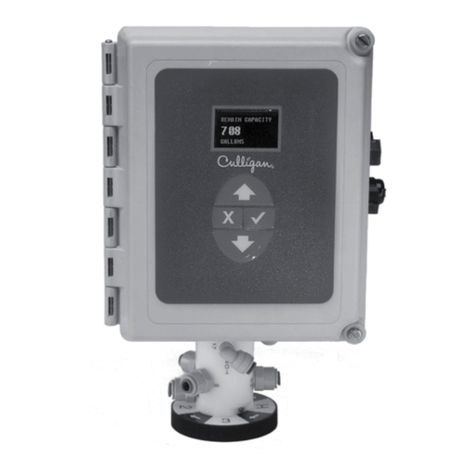
Operation 5
Cat. No. 01021161
Operation
Modes of Operation
Time Clock
The Smart Controller (GBE) will initiate a regeneration based upon a time schedule of intervals of days (such as every
three days) or on a specific day of week schedule (such as Mondays, Wednesdays and Saturdays). Because regenera-
tion will occur at the prescribed schedule regardless of water use, this method is usually the most inefficient method of
water softener operation.
Flow Meter/Sensor
When a flow meter or sensor is connected to the controller circuit board, the Smart Controller has the ability to measure
the amount of water treated and initiate a regeneration sequence based upon the gallon capacity of the water treatment
equipment. The controller can delay the regeneration signal until a convenient time of day (known as a delayed regenera-
tion) or act and initiate the regeneration sequence as soon as the signal is received (known as immediate regeneration).
When installing an alternating duplex system (one tank on-line, the other in standby), only one flow measuring device is
required to be installed in the common outlet header of the system. Parallel systems (multiple tank systems, all on-line
simultaneously) require one flow device for each mineral tank in the system.
This method is a proven, cost-effective means to operate a water softening system.
Aqua-Sensor® (Softener use only)
The Aqua-Sensor® detects when a softener resin bed has reached its point of exhaustion and, as a result, initiate a regen-
eration sequence. This is the most cost-effective method of operation and may be combined with any of the operational
modes previously described.
Progressive Flow
The Progressive Flow mode is used with up to six and as few as two mineral tanks in a system. It allows more than one
tank in a system to either be on-line or off-line depending upon the downstream flow demand. If flow demand is greater
than the flow capability of the tank on-line, another tank can be brought on-line to help satisfy the excess demand. Once
the demand has decreased, the second tank is returned to a standby mode and the system reverts to just one tank on-line
providing treated water.
The progressive flow mode of operation relies on a user programmable set point or Trip Point. The Trip Point is a unit of
flow (gallons or liters) on a per minute basis. Once attained the trip point will cause the second unit (in multiple resin tank
system) to come on-line. Each additional tank in the system will subsequently be brought on-line as multiples of the trip
point are attained and remain in that state for ten seconds. (Example: a three-tank system with a trip point of 50 gpm will
bring two tanks on-line once the facility flow demands is equal to or greater than the 50 gpm trip point. Should the flow
demand reach 100 gpm or more, the third tank shall be brought on-line.)
Additional tanks will be returned to stand-by once the facility flow demand is: less than 95 percent of the trip point for two
tank systems; less than 95 percent of two times (2X) the trip point for triplex systems; less than 95 percent of three times
(3X) the trip point for quad systems; and remaining in that state for 30 seconds.
Utilizing the progressive flow feature may allow the owner to use smaller units, resulting in the potential for reduced capital
and operation costs.
Unbalanced Progressive Flow
Similar to regular Progressive Flow, this mode is used when maximum and minimum flow rates have a wide fluctuation.
In this mode you can have one tank that is smaller than the others. This tank has a separate Trip Point set so the Smart
Controller knows what flow rate it can run at. The additional larger tanks are brought on-line when the trip point of the
smaller tank is exceeded. The small tank is only online during low flow conditions. The small tank must be set up as the
master tank.
Differential Pressure (Filters Only)
When combined with an optional differential pressure device, the Culligan Smart Controller has the ability to initiate a
backwashing sequence when the pressure differential across the media bed reaches a preset amount (usually 8–10 psi).




























